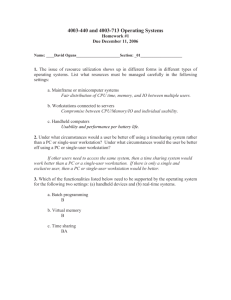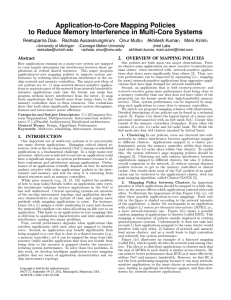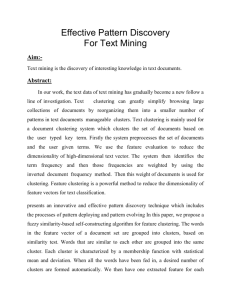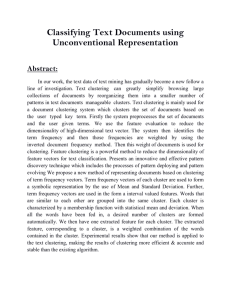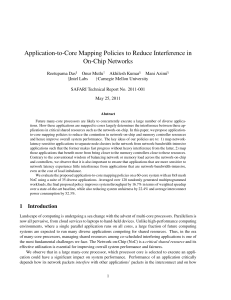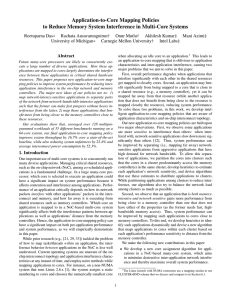Application-to-Core Mapping Policies to Reduce Memory System Interference
advertisement
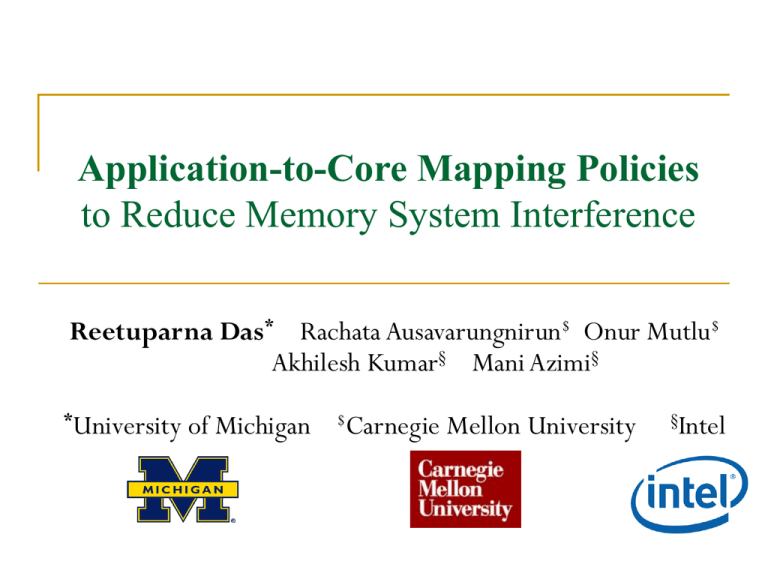
Application-to-Core Mapping Policies to Reduce Memory System Interference Reetuparna Das* Rachata Ausavarungnirun$ Onur Mutlu$ Akhilesh Kumar§ Mani Azimi§ *University of Michigan $Carnegie Mellon University §Intel Multi-Core to Many-Core Multi-Core Many-Core 2 Many-Core On-Chip Communication Applications Light Memory Controller Heavy $ $ Shared Cache Bank 3 Task Scheduling Traditional When to schedule a task? – Temporal Many-Core When to schedule a task? – Temporal + Where to schedule a task? – Spatial Spatial scheduling impacts performance of memory hierarchy Latency and interference in interconnect, memory, caches 4 Problem: Spatial Task Scheduling Applications Cores How to map applications to cores? 5 Challenges in Spatial Task Scheduling Applications Cores How to reduce communication distance? How to reduce destructive interference between applications? How to prioritize applications to improve throughput? 6 Application-to-Core Mapping Improve Bandwidth Utilization Improve Bandwidth Utilization Balancing Radial Mapping Clustering Isolation Improve Locality Reduce Interference Reduce Interference 7 Step 1 — Clustering Memory Controller Inefficient data mapping to memory and caches 8 Step 1 — Clustering Cluster 0 Cluster 2 Cluster 1 Cluster 3 Improved Locality Reduced Interference 9 Step 1 — Clustering Clustering memory accesses Locality aware page replacement policy (cluster-CLOCK) When allocating free page, give preference to pages belonging to the cluster’s memory controllers (MCs) Look ahead “N” pages beyond the default replacement candidate to find page belonging to cluster’s MC Clustering cache accesses Private caches automatically enforce clustering Shared caches can use Dynamic Spill Receive* mechanism *Qureshi et al, HPCA 2009 10 Step 2 — Balancing Applications Cores Heavy Light Too much load in clusters with heavy applications 11 Step 2 — Balancing Applications Cores Heavy Light Better bandwidth utilization Is this the best we can do? Let’s take a look at application characteristics 12 Application Types (c) PHD Comics13 Applications Application Types Sensitive Medium High Miss Rate Low MLP Med Miss Rate High MLP Heavy Light High Miss Rate High MLP Low Miss Rate Thesis Committee Identify and isolate sensitive applications while ensuring load balance Advisor Sensitive Guru There for cookies Adversary Bitter rival Nice Guy No opinions Asst. Professor (c) PHD Comics14 Step 3 — Isolation Applications Cores Sensitive Light Medium Heavy Isolate sensitive applications to a cluster Balance load for remaining applications across clusters 15 Step 3 — Isolation How to estimate sensitivity? High Miss— high misses per kilo instruction (MPKI) Low MLP— high relative stall cycles per miss (STPM) Sensitive if MPKI > Threshold and relative STPM is high Whether to or not to allocate cluster to sensitive applications? How to map sensitive applications to their own cluster? Knap-sack algorithm 16 Step 4 — Radial Mapping Applications Cores Sensitive Light Medium Heavy Map applications that benefit most from being close to memory controllers close to these resources 17 Step 4 — Radial Mapping What applications benefit most from being close to the memory controller? High memory bandwidth demand Also affected by network performance Metric => Stall time per thousand instructions 18 Putting It All Together Inter-Cluster Mapping Clustering Balancing Isolation Intra-Cluster Mapping Radial Mapping Improve Locality Reduce Interference Improve Shared Resource Utilization 19 Evaluation Methodology 60-core system x86 processor model based on Intel Pentium M 2 GHz processor, 128-entry instruction window 32KB private L1 and 256KB per core private L2 caches 4GB DRAM, 160 cycle access latency, 4 on-chip DRAM controllers CLOCK page replacement algorithm Detailed Network-on-Chip model 2-stage routers (with speculation and look ahead routing) Wormhole switching (4 flit data packets) Virtual channel flow control (4 VCs, 4 flit buffer depth) 8x8 Mesh (128 bit bi-directional channels) 20 Configurations Evaluated configurations BASE—Random core mapping BASE+CLS—Baseline with clustering A2C Benchmarks Scientific, server, desktop benchmarks (35 applications) 128 multi-programmed workloads 4 categories based on aggregate workload MPKI MPKI500, MPKI1000, MPKI1500, MPKI2000 21 System Performance 1.3 BASE BASE+CLS A2C Normalized Weighted Speedup 1.2 1.1 1.0 0.9 0.8 MPKI500 MPKI1000 MPKI1500 MPKI2000 Avg System performance improves by 17% 22 Network Power Normalized NoC Power 1.2 BASE BASE+CLS A2C 1.0 0.8 0.6 0.4 0.2 0.0 MPKI500 MPKI1000 MPKI1500 MPKI2000 Avg Average network power consumption reduces by 52% 23 Summary of Other Results A2C can reduce page fault rate Normalized Page Faults % Accesses within Cluster 120 100 80 CLOCK cluster-CLOCK 60 40 20 0 1.2 1.0 0.8 0.6 0.4 0.2 0.0 0 5 memory footprint of workload (GB) 10 0 5 10 memory footprint of workload (GB) 24 Summary of Other Results A2C can reduce page faults Dynamic A2C also improves system performance Continuous “Profiling” + “Enforcement” intervals Retains clustering benefits Migration overheads are minimal A2C complements application-aware packet prioritization* in NoCs A2C is effective for a variety of system parameters Number of and placement of memory controllers Size and organization of last level cache *Das et al, MICRO 2009 25 Conclusion Problem: Spatial scheduling for Many-Core processors Develop fundamental insights for core mapping policies Solution: Application-to-Core (A2C) mapping policies Clustering Balancing Isolation Radial A2C improves system performance, system fairness and network power significantly 26 Application-to-Core Mapping Policies to Reduce Memory System Interference Reetuparna Das* Rachata Ausavarungnirun$ Onur Mutlu$ Akhilesh Kumar§ Mani Azimi§ *University of Michigan $Carnegie Mellon University §Intel
